Sourdough Pumpernickel Bread
This Sourdough Pumpernickel Bread recipe makes the perfect sandwich bread. It’s a hearty loaf made with whole grain rye flour, whole wheat flour, bread flour and a couple of unusual ingredients.
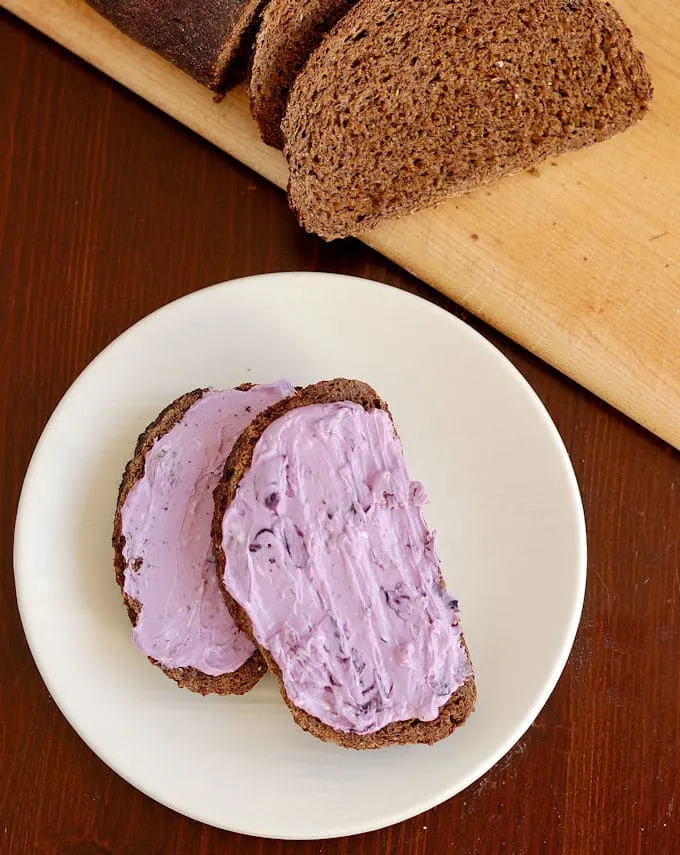
As I mentioned in my Rye Bread post, I grew up in New Jersey, just outside of New York City. Being near to New York meant having access to wonderful delis and bakeries, so it was easy to find a good deli sandwich on fresh bread.
The other day I had some dried-out slices of sourdough bread left over and rather than throw them away I was inspired to make a Sourdough Pumpernickel Bread recipe.
If you don’t have one, check out my post to learn How to Make a Sourdough Starter. Then check out my system to Feed and Maintain Sourdough Starter.
What is the difference between Rye Bread and Pumpernickel Bread?
Rye Bread is made with some proportion of Rye Flour, often mixed with wheat flour for structure.
Pumpernickel bread is also made with rye flour, and it includes added ingredients to create dark brown color and complex flavor. There are different techniques and ingredients bakers can use to create the dark brown color in the bread.
In my research I found old recipes that use left over bits of bread as a basis for a new loaf of bread. Waste not, want not, right? I could see that toasted bread crumbs would add an interesting texture and deep flavor to pumpernickel bread.
I settled on a combination of coffee, barley malt syrup, cocoa and toasted bread crumbs to deepen the color of the loaf. These ingredients contribute a really interesting bitter/sweet flavor to the bread.
Sourdough pumpernickel bread recipes use anywhere from just a hint of rye flour, to all rye flour, and every combination in between.
Without gluten from wheat flour, the loaf would be too dense. There are some traditional European all-rye pumpernickel loaves that are super concentrated and very, very dense. They’re interesting in and of themselves, but that’s not the type of pumpernickel I was going for.
This recipe has a proportion of 1/2 rye flour, and 1/2 wheat flour. There’s just enough whole wheat flour to contribute to the flavor. Bread flour makes up the balance so there’s enough elasticity for a good rise on the loaf.
Ingredients
- Unfed sourdough starter (100% hydration)
- Water
- Rye flour
- Coffee
- Barley malt syrup
- Cocoa powder
- Table salt
- Bread crumbs
- Whole wheat flour
- Bread flour
How to make Sourdough Pumpernickel Bread
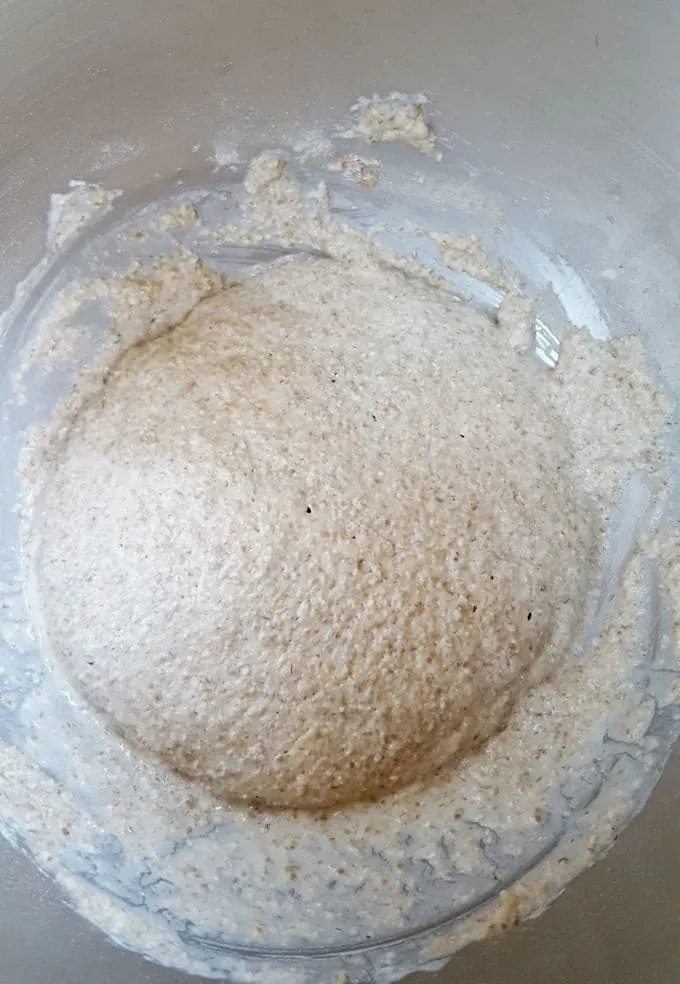
- Combine unfed starter with rye flour and water. Several hours later the rye starter is active and ready to use.
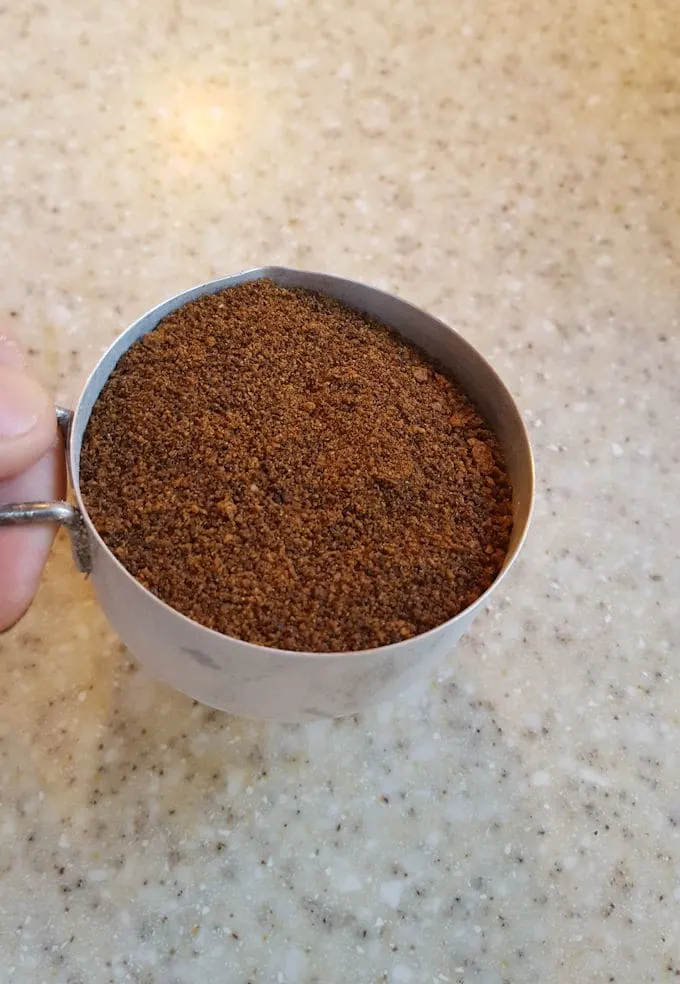
- Grind the toasted bread crumbs until they resemble coffee grounds
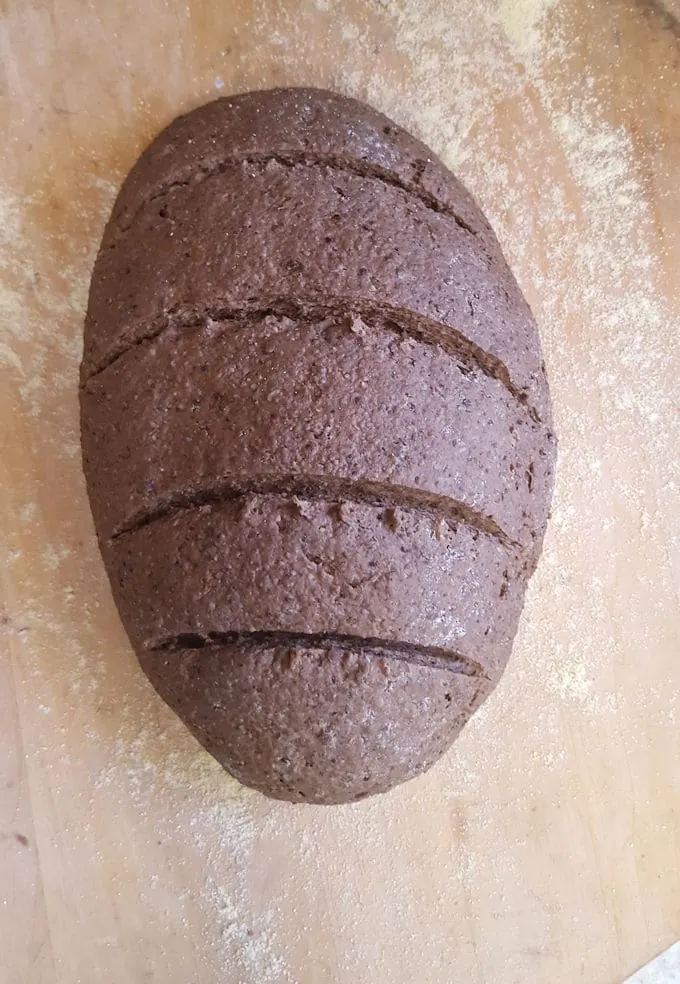
- Slash the risen loaf and brush with egg white for a shiny crust. Bake until the internal temp is 200f.
Tips for making Sourdough Pumpernickel Bread:
- Whenever you’re working with sourdough you’ve got to be flexible with the timing. The fermentation and rising times can vary based on how active your starter is, the dough temperature, the room temperature, etc.
- After three hours of rising and folding the dough should be resilient and airy. If after 3 hours the dough still feels very dense you can give it another hour or two rising time or you can put it in the refrigerator overnight for a long, slow rise.
- After shaping the dough you can refrigerate the loaf overnight and bake in the morning. The extra-long rise in the refrigerator will give the bread and even deeper flavor.
- For a flavor variation, fold in 1 tablespoon of caraway seeds just before shaping the loaf.
- This dough can also be portioned and rolled into individual balls to make rolls. Cut into 8 portion for larger sandwich rolls and 12 portions for smaller rolls.
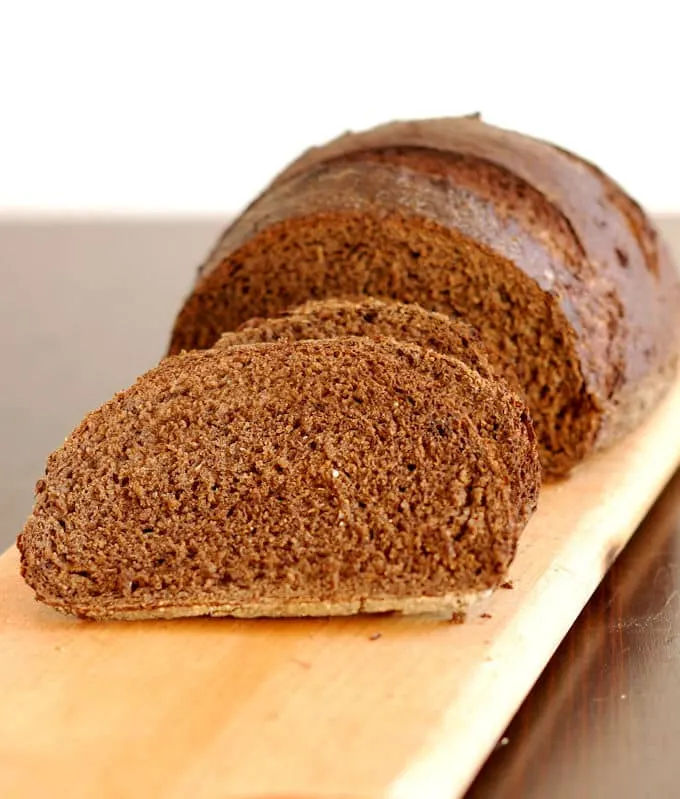
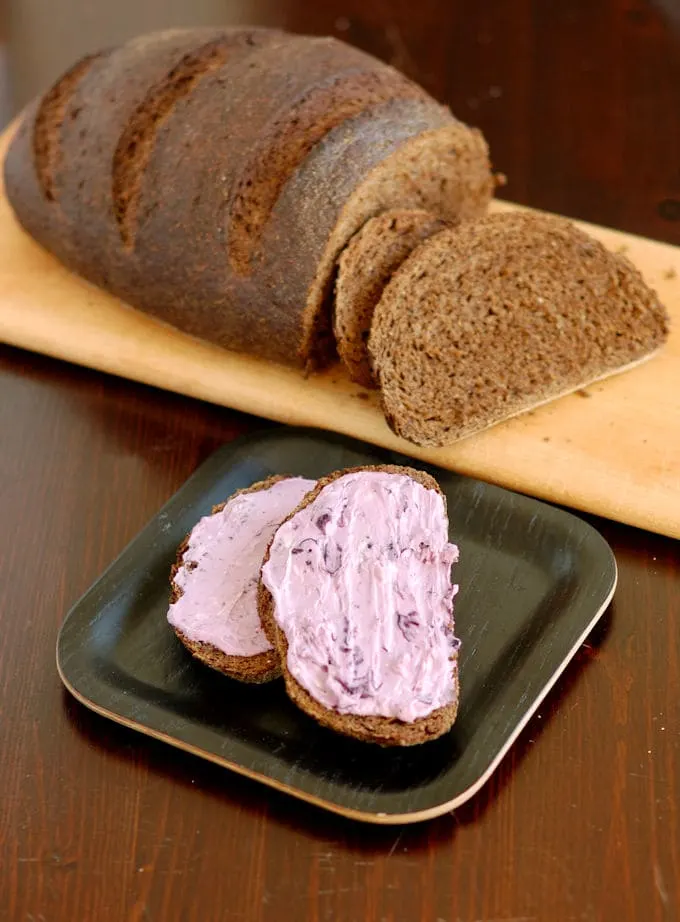
Sourdough Pumpernickel Bread is my favorite bread for making a tuna sandwich. It’s also great for breakfast with blueberry cream cheese or any creamy topping. This bread makes a killer grilled-cheese sandwich.
I know you hate to throw away that sourdough discard. Check out these recipes that use sourdough discard.
If you love this recipe, please consider giving it 5 stars.
Sourdough Pumpernickel Bread
Ingredients
Rye Starter
- 4 ounces unfed sourdough starter (about ½ cup (100% hydration))
- 2 ounces warm water (¼ cup)
- 2 ½ ounces rye flour (½ cup, see note)
Dough
- 10 ounces coffee (1 ¼ cups, room temperature)
- 1 ½ ounces barley malt syrup (2 tablespoons (see note 2))
- 1 tablespoon cocoa powder
- 1 1/2 teaspoons table salt
- 5 ounces rye flour (1 cup)
- 2 ounces toasted bread crumbs (½ cup (see note 3))
- 2 ½ ounces whole wheat flour (½ cup)
- 5 ounces bread flour (1 cup)
Instructions
Make the Rye Starter (one day before)
- Combine the sourdough starter, water and rye flour.4 ounces unfed sourdough starter, 2 ounces warm water, 2 ½ ounces rye flour
- Cover the bowl and let it ferment about 6-8 hours at room temperature (you can do this the night before and continue making the dough in the morning).
Make the Dough
- In the bowl of a stand mixer with a dough hook or a large a large mixing bowl, combine the active rye starter with the coffee, barley malt syrup, cocoa, salt, rye flour, toasted bread crumbs and whole wheat flour.10 ounces coffee, 1 ½ ounces barley malt syrup, 1 tablespoon cocoa powder, 1 1/2 teaspoons table salt, 5 ounces rye flour, 2 ounces toasted bread crumbs, 2 ½ ounces whole wheat flour
- Add the bread flour. If working by hand, stir in as much of the flour as you can, then turn the dough out onto a lightly floured surface and knead in the remaining flour. Knead 5 minutes. Knead the dough into a smooth ball. The dough may still be a little soft and tacky but should form into a smooth ball.5 ounces bread flour
- Place the dough into an oiled bowl, turning once to coat. Cover and set at room temperature for 1 hour. After an hour, working from four corners of the dough (still in the bowl) use your hand to lift the top edge of the dough over into the middle of the dough. Repeat with the other 3 sides then flip the dough over. Cover and set at room temperature for another hour. Repeat the folding procedure 2 more times so the dough rises for a total of 3 hours. By now the dough should be lively, elastic and airy. If the dough is still sluggish give it another hour or two at room temperature. After the initial fermentation the dough can be refrigerated for up to 2 days before baking.
- Turn the dough out onto a floured surface and fold each of the four sides into the middle again. Flip the dough over, shape into a ball then roll the edges to form an oval shape. Transfer the loaf to a sheet pan lined with parchment paper or onto a baking peel dusted with cornmeal. If you want to bake in a Dutch oven shape the dough in to a round (boule) and preheat the pan in the oven.
- Cover the dough with plastic wrap or a damp kitchen towel and rise until almost doubled in volume (about 1 – 1 ½ hours). the rising time will vary base on how active your starter was, the room temperature, etc.
- While the dough rises preheat the oven to 375 °F. If you have a baking stone put it in the oven to preheat. When the bread is risen, use a sharp knife or blade to slash the top of the bread 4-5 times.
- If using the Dutch oven to bake follow these directions: Remove the preheated pan from the oven and remove the lid. Use the parchment paper to lift the loaf into the Dutch oven. Replace the lid on the pot and slide it into the oven. Bake for 20 minutes. Remove the lid from the Dutch oven. The loaf should be well risen and pale in color. Continue baking another 20 minutes until the loaf is nicely browned and beginning to crisp. Remove the pan from the oven. Use the parchment to lift the loaf out of the pan.
- If baking on a sheet pan or baking stone bake until the temperature reaches 200°F in the center of the loaf, about 35 minutes.
Would you like to save this recipe?
As an Amazon Associate and member of other affiliate programs, I earn from qualifying purchases.

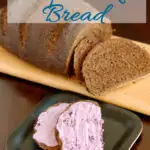
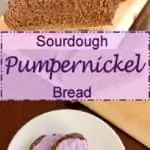
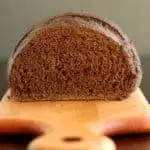





I would like to know why you use unfed starter in this recipe?
Thank you
Pris
Use an unfed starter because you’re going to feed it with rye flour. If your starter is already made with rye flour you can just go ahead and start at step 3.
OH! This would be a good change from the regular loaf. My family would really like it.
Bread turned out beautifully. Used my kitchen aide to mix, added additional flour in place of breadcrumbs, 1-tbsp of Vital wheat gluten to help with rise & caraway seeds on second strength & fold. Shaped oval with overnight cold ferment. Baked in a Dutch oven @400F, 25-min with lid on, 20 min off. Not a huge oven spring but still perfect for sandwiches; light, lovely texture, small air pockets. . Do believe it may have had better oven spring if I baked it after a couple of hours cold ferment as initially it rose beautifully. Will definitely make again with additional experimentation.
I’m a little confused. Isn’t the “real” pumpernickel you seek made with pumpernickel rye flour, not with rye flour dyed with coffee? Have you tried both?
As I discussed in the post, I wanted to make a pumpernickel bread of the type found in NY delis. Not the dense European pumpernickel bread made with rye berries and no wheat flour. “Pumpernickel” flour is rye flour. Even if you use a whole grain rye flour (which I do) labeled “pumpernickel” the resulting bread would not be dark brown without some other ingredients contributing that dark color. I use toasted bread crumbs, barley syrup, cocoa and coffee. The bread is not simply “dyed” with coffee. All those ingredients contribute flavor as well as color to the finished bread. That color and flavor is what distinguishes pumpernickel (NY style) from whole grain rye bread.
Can I replace the whole wheat flour with white rye or half white rye half bread flour?
Well, you will be reducing the gluten in the dough because Whole Wheat flour does have more gluten than rye flour. I would say you’d be better off with half white rye and half bread flour.
My loaf ended up flat and disappointing, though the flavor was good. When I finished mixing it, it looked great and was firm enough to hold its shape. However, the dough got softer with each rise and just didn’t have enough heft to maintain its beautiful oval shape. I was so sad when I saw it after the final rise but hoped it would expand upward rather than sideways while baking. No such luck. I may (but probably not) try it again but would make the dough much stiffer.
Ann,
The same thing happened to me! It was so beautiful before the last rise. I’m thinking that I may try it again in a loaf pan?
I made the sourdough pumpernickel bread, it took a couple of days but it was worth the wait. The sourdough was very active the second day and the bread really had a nice rise. Thank you for your recipe.
I only have KA white whole wheat flour in the hose. Can I assume I could use it in place of the 1/2 cup regular whole wheat flour? It would probably make the loaf a little lighter in color than regular whole wheat?
Yes, you can give it a try. It’s a pretty dark bread anyway so I think you’ll still have a nice color.
Hi thank you for the recipe. Ive been making sour dough for about month.now. the loaf I made tastes great but is very flat although has air holes. Just looking for any advice, as I really like it and want to try again. I know my starter is active and had a good bulk and proof rise. The dough was pretty wet. I used a clay cooker on 400. Do you have any suggestions or should I use s higher oven temp,?
Well I tried again used a dutch oven at 450 and added more bread dough and a little less liquid. It seemed to shape better and rose well but still poor oven spring, arg. But tastes great, I added sesame seeds in top which added a nice flavor. If anyone has advice to help oven spring with this recipe i’d appeciate it.
Thanks
@Chris, I haven’t tried this recipe yet but have baked MANY loaves of sourdough rye bread with overnight fermentation which works and tastes really good. I use a rye starter also. I use to make boules but have gone back to bread pans for a more sandwich type of bread and awesome oven spring…but most of the rise happens overnight in the fridg. I take it out of the fridg and right into a preheated oven. The boules are nice once in a while but proofed in a banneton type of bowl…just my opinion, good luck.
I love the dark color of your bread. Can I substitute non-diastatic malt powder? Will it lighten the color? Or should I buy syrup to ensure a dark loaf?
The malt syrup is for a little sweetness and color. Non-diastatic malt powder will add a nice flavor and sweetness but not the color. Even without the malt syrup you should get good color from the toasted crumbs, coffee, cocoa and rye flour. So go ahead and use a little malt powder for flavor. You could also use a combination of honey and molasses to replace the malt syrup.
I have a question now that I am in the process of trying your intersting recipe. I was up fairly early to check on the rye starter which was ready to go by 6:30 am. So it is in the bulk rise stage now at 11:30 am. Can I leave it to become light and airy most of the day at room temperature & then shape it for the banneton & set in the fridge ro bake in the morning? That would mean it is on the counter at room temperture for 10 hours before shaping & going in fridge overnight. (our house is cool as we are in central Alberta).
Yes, I often mix the dough and just leave it at room temperature all afternoon. You can also shape and refrigerate a little earlier in the day. A few extra hours in the fridge won’t matter either.
I’ve been baking sour dough bread for a couple of months now and love it. I tried this recipe and the flavour is awesome….the only thing that didn’t work for me was that the dough was very wet and I thought I added enough flour when kneading as it seemed that this recipe called for a wetter dough than other sour dough recipes. However, each rise it was quite wet to fold over and although the bread has air holes, it was quite flat. So my question is, when you do the air folds, can you pull it out of the bowl and knead it with more flour if it is too wet? or does that ruin the rise? thanks!
You could pull the dough out of the bowl and knead in more flour if you feel you need it. Bread dough is super-adaptable and resilient.
Thanks – I will try it again! Just made your brownies and looking forward to trying them 🙂
If I make two small loaves and cook them separately (I only have one Dutch oven) how would I change the oven temp or cooking time?
No need to change the oven temp, but a smaller loaf would certainly baker faster. I would start checking at about 20-25 minutes. The interior temp of the loaf should register 190-200F.
My first Pumpernickel!! Love love love!! The coffee, cocoa and molasses give it a wonderful richness!! I didn’t add the bread crumbs but added a little more Einkorn flour. And caraway seeds. Plus refrigerated overnight. Thank for simple straightforward recipes that work!! Blessings. ❤#fromthegardentothetable
Hi Eileen, I want to start off by saying thank you for the recipe. I’m just about to start making it since I finally found a place to sell fresh rye flour. More than excited at this point. The only question I have is about the rye starter. Do I still have to do a float test after the rye starter in a jar overnight before proceed all the steps. Hope to hear from you soon and thank you again.
You don’t have to do the float test if you know your starter is active. It’s just another indicator that your starter is ready for baking.
Awesome! Thank you so much for your reply!
Can this be baked in a Dutch oven like your rye sourdough recipe? If so, still 350 degrees?
Yes. With the Dutch oven I’d go a little hotter, maybe 400F.
I made it in a Dutch oven and it turned out with an “artisan-like crust” and a great oven spring (extra 20% rise). However, be careful of the oven temp and position of a the Dutch oven in the oven as the bottom might brown too quickly. I baked it at 450, 20 minutes covered, 25 minutes uncovered. Also, be sure to let the loaf rest for a long time, I suggest overnight, or it might appear doughy in the center. Be patient, the flavor of this bread is worth the wait.
Thanks Eileen for sharing your recipe! It is delicious.
Looking to make pumpernickel with raisins for my dad. Would this be a good recipe to add raisins to?
Sure. Fold the raisins in when shaping the dough.
I have to say I am so impressed with myself . I made this exact to recipe and it came out perfect. This was my first attempt to use a made from scratch sourdough starter and though I was dubious it WORKED!! The bread didn’t seem to rise as much as I expected but made up during the bake. An absolutely beautiful loaf of bread.
Congrats and welcome to the world of sourdough! The times on sourdough recipes are always a little variable based on how active your starter is, the room temp, dough temp, etc. You can always give the dough a little more time if it doesn’t seem to rise enough. Glad you came out well. It’s a personal favorite (especially for tuna sandwiches!).
Why do you use bread crumbs in the recipe. Can I omit them?
Hi Joy. I used the toasted bread crumbs because I saw that most of the old traditional recipes included toasted crumbs. The crumbs do contribute to the color and flavor of the loaf. If you don’t have old bread you could use packaged breadcrumbs or even crumbled saltine crackers. If you eliminate the crumbs all together you’ll probably get a slightly lighter color on your loaf. Also, you may need to add a little more flour if the dough is very wet. I think you’ll still get a good loaf though.
Il pane e buonissimo !qui in Italia e difficcile trovare il vero pumpernickel xcio me lo sona fatta a casa seguendo la ricetta e un vero successo!
I put your comment through Google translate and I think you’re saying that’s it’s hard to find Pumpernickel bread in Italy and that you made this bread and it was good. If that’s why you said, thanks! I’m glad you like the recipe.
Where do you get rye flour? I have looked for it many times but can never find it.
Hi Barb, the markets in my area sell rye flour in the baking aisle. You can also buy it on-line.
Hello, your recipe looks great and I am anxious to try it. A couple questions….is your starter 100%? I usually work in grams instead of cups, etc. Wondering if this will work if I convert it??
Hi Rebecca. I use a 100% starter, that is, fed with equal weights of starter-water-flour.
thanks! that helps so much!
Sure, and thanks for the question. Reader questions always help me clarify the recipe.
I do love baking bread! And I can’t get enough rye breads – they just bake so well and smell so good. I’ve yet to make a pumpernickel, I think this just got added to my weekend menu! Thank you!
Hope you like it. I love it!